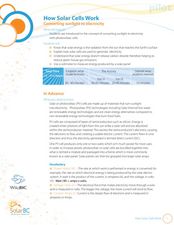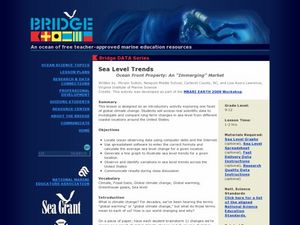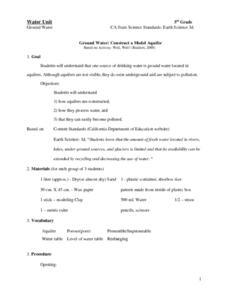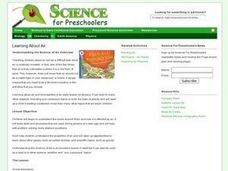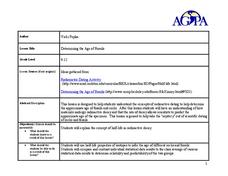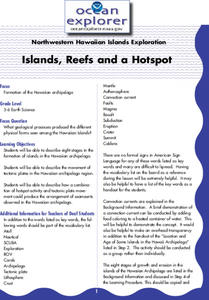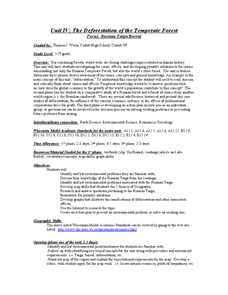Curated OER
NASA Anniversary
For this NASA Anniversary worksheet, students complete activities such as reading a passage, phrase matching, fill in the blanks, correct words, multiple choice, spelling, sequencing, scrambled sentences, writing questions, survey, and...
Curated OER
Mammals of Fields, Meadows, and Hedgerows
In this mammals worksheet, students research the internet to find information and answer short answer questions about mammals of fields, meadows, and hedgerows. Students complete 12 questions.
Curated OER
How Solar Cells Work: Converting Sunlight to Electricity
Learners examine how to convert sunlight to electricity. In this renewable energy sources lesson students explain how solar cells are used and use a voltmeter to measure the energy produced by a solar panel.
Curated OER
Ceres and Pluto: Dwarf Planets as a New Way of Thinking about an Old Solar System
Students examine the new categories of planets and how planets were reclassified. In this solar system lesson plan students complete activities using Venn diagrams and images of planets.
Curated OER
After the Garbage Can: Where Does Our Trash Go?
Students explore how waste disposal has changed over time and what the current issues are. In this disposal lesson students collect data and create graphs.
Curated OER
Sea Level Trends ~ Ocean Front Property: An "Immerging" Market
Young oceanographers take a look at sea level data from several cities over a few centuries. They use the data to fuel a discussion about what kind of changes are taking place and the impact they are having on the coastal ecosystems....
Curated OER
Dirt: Making Dirty Water Clean!
Fourth graders study soil and water. In this water activity students work in groups and use a filter to clean water.
California Academy of Science
Measuring Earthquakes
After a brief discussion on earthquakes, make a makeshift seismograph to record the shaking of the table that it sits upon. While the background information will be useful to you as a teacher, the seismograph does not seem like it would...
Curated OER
Fun with Fossils
Second graders explore the geologic process of fossil formation. In this geology instructional activity, 2nd graders discuss the job of a paleontologist and make their own model of a fossil. This instructional activity includes teacher...
Curated OER
Classification of Clouds
Students view a cloud slide show presentation and identify types of clouds. They estimate height based on cloud's appearance. They discuss the vague nature of cloud nomenclature and compare it to the English standard measurement system.
Curated OER
Ground Water: Construct a Model Aquifer
Students recognize that one source of drinking water is ground water located in aquifers. They create a model of an aquifer and summarize their experience in a report.
Curated OER
The Time of Man
Students demonstrate visually Mankind's relative place on the earth's timeline. They familiarize themselves with the use of the metric system in measuring and producting a timeline.
Curated OER
Roots of the Hawaiian Hotspot
Students explain the processes of plate tectonics and volcanism that resulted in the formation of the Hawaiian Islands. They describe, compare, and contrast S waves and P waves. They explain how
Curated OER
I Can See and Feel the Change in the Seasons
Students use their senses to investigate the changes in the seasons. They discuss how the Earth moves around the sun and its tilt. They practice using new vocabulary and examining the different seasons.
Curated OER
Learning about air
Students read a book and have a class discussion about the air around them. In this air lesson plan, students learn about properties of air, and discuss other gases they have observed.
Curated OER
Determining the Age of Fossils
Students examine the concept of radioactive dating. In this radioactive dating lesson, students investigate how to determine the ages of fossils and rocks as they learn about half-life radioactive decay.
Curated OER
Islands, Reefs, and a Hotspot
Students describe eight stages in the formation of islands in the Hawaiian archipelago. They examine the movement of tectonic plates in the Hawaiian archipelago region, and describe how plate movement produced the Hawaiian archipelago.
Curated OER
Mapping Deep-Sea Habitat
Learners create a two-dimensional topographic map and a 3-D model of landforms. In this creative lesson students create 2 and 3-D objects and learn how to interpret the data from these things.
Curated OER
Graphing Changes in Weather
Students graph current temperature and weather conditions for three days. In this weather instructional activity, students go to the Weather Channel's website and look up weather for their zip code then graph the conditions and...
Curated OER
Climate change in Canada
Learners investigate the impact of human activity on the environment. In this secondary math/science lesson, students analyze and interpret information from data and graphs as they investigate trends in climate change and the...
Curated OER
The Deforestation of the Temperate Forest Focus; Russian Taiga/Boreal
Twelfth graders complete a unit of lessons on the Russian Temperate Forest. They list the environmental problems associated with deforestation, conduct research, compare the Russian Taiga with other forests, create graphs, and develop an...
Curated OER
Landforms
Young scholars begin their examination of landforms. Using a map, they locate and identify the major landforms on Earth. They discuss how landforms affect the lifestyle of the community and determine which goods and services the...
Curated OER
The Six Kingdoms
In this classification worksheet, students complete a chart listing the characteristics of each of six kingdoms. They write definitions for three terms.
Curated OER
Algal Blooms
In this algal blooms worksheet, students order the stages of a red tide. They answer two short answer questions. Students define three terms relating to algal blooms.




